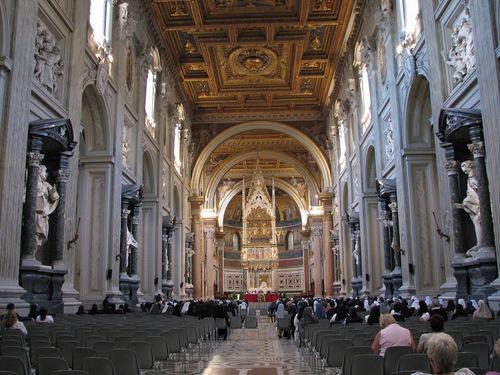
The
Churches of Rome
The locations of all places are shown on my Google-Earth Map
The Lateran
Google-Maps, (enlarge the magnification, this map is in 3-D)
The Earliest Papal Center
Basilica
San Giovanni in Laterano
Dedicated to John the Baptist and John the Evangelist, the Basilica of St. John Lateran (Basilica di San Giovanni in Laterano). Built by Constantine the Great in the 4th century, San Giovanni in Laterano is the Cathedral of Rome, the Archbasilica of the Popes, not St. Peter in Vaticano. Until the 16th century the Popes resided in the adjacent Lateran Palace, which Constantine raised on the former barracks of the imperial guard.

Interior of San Giovanni in Laterano today (last reconstruction 1735)
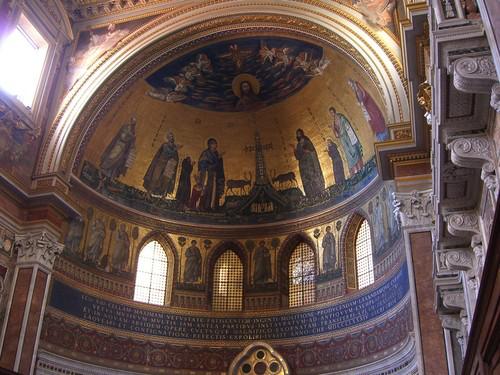
The Apsis Mosaic (5th cent. restored)
First built by Constantine the Great in 315, the structure is one of the oldest Christian buildings in Rome and the oldest baptistery in Christendom. It provided the model for later versions, including the Byzantine baptisteries at Ravenna. Churches did not contain their own baptisteries at this early date, and San Giovanni in Fonte was the only place to be baptized in Rome until the late 300s. At that time, baptisms were held only at Easter.
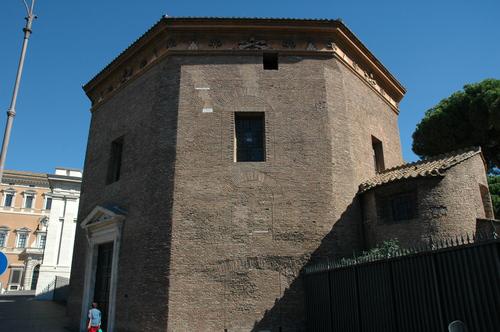
The Baptisterio as built by Constantine 315
In the 5th century, Constantine's original baptistery was internally remodelled (roof structure) by Pope Sixtus III (432-40) in a similar style as the Mausoleum of Santa Costanza, including the addition of a narthex. A few decades later, Pope Hilarius (461-68) added side chapels dedicated to the two St. Johns.
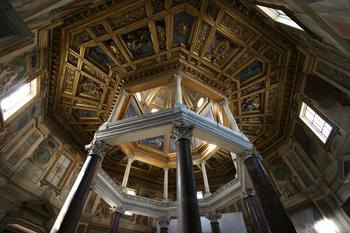
Interior and roof structure in the baptistry (437)
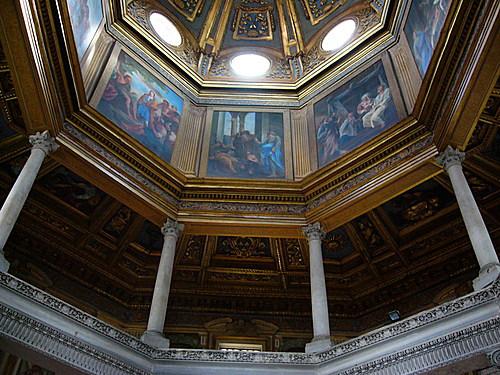
Upper tiers
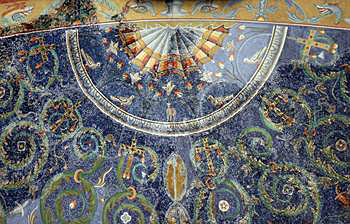
Mosaic in the Chapel of St. Venantius, Baptistery of San Giovanni in Laterano (648)
Pope John IV (640-42) added the Chapel of St. Venantius, the largest of the three side chapels. John IV was one of the first popes to transfer martyrs' bones to churches in Rome. He brought the remains of Venantius, Anastasia and Maurus from Dalmatia to place in his chapel. A few years later, under Pope Theodore I (642-49), the chapel was decorated with mosaics.
San
Giovani in Laterano
The Cloisters of the Benedictine Monastery,
13th
cent.

The cloisters, all that remains of the original Benedictine monastery, date from the early 13th century. Their design, by Vassellectus and the Cosmati brothers, is an intermediate style between Romanesque and Gothic.
Basilica
San Clemente
The
most
interesting and beautiful church in Rome 4th
- 15th cent
The
church has a beautiful interior, but it is especially notable for its
three historical layers. The 12th-century basilica is built on top of
a well-preserved 4th-century church (with many frescoes), which was
built next to a 3rd-century Mithraic
Temple.
For an admission fee, it is possible to explore the excavations of
the lower two levels, which is a fascinating journey into the history
of Rome.
This
ancient church was transformed over the centuries from a private home
and site of clandestine Christian worship in the first century to a
grand public basilica by the 6th century, reflecting the emerging
Roman Catholic Church's growing legitimacy and power.
In the late
1st
century AD, an insula
(apartment building) and mansion
were built here, separated by a narrow Roman street. These were built
on top of earlier structures that were destroyed in the great fire of
64 AD under Nero.
A Christian community is believed to have met
in the mansion by the 2nd
century. The community
was known as the titulus Clementis,
which according to custom was probably named for the owner of the
mansion. Some believe this was the Roman consul and Christian martyr
Titus
Flavius Clemens (d.
215).
In the early 3rd century, the inner courtyard of the insula
was made into a Mithraeum,
or Temple of Mithras. Mithras was a sun god of Persian origin whose
cult was for men only and involved secret initiation rituals in
small, cave-like sanctuaries.
The Upper Church 12th to 15th cent
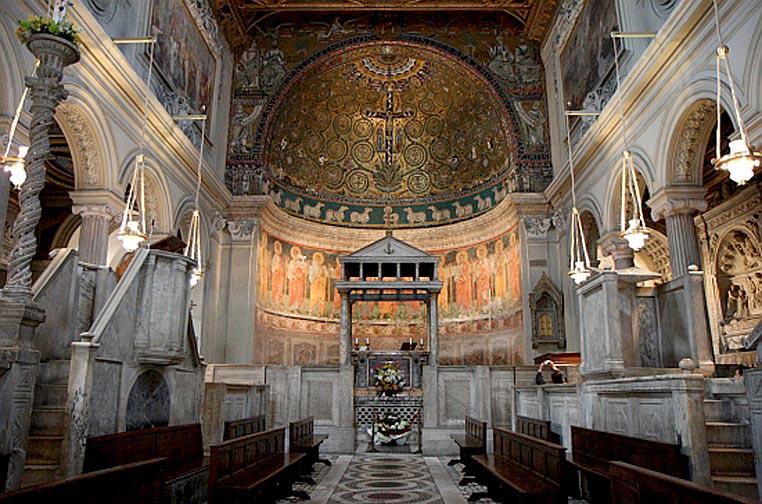
The nave of the main, upper church of San Clemente is one of the most richly decorated churches in Rome. The vast majority of its architecture and art dates from its construction in the early 12th century. The entrance is on the left aisle.
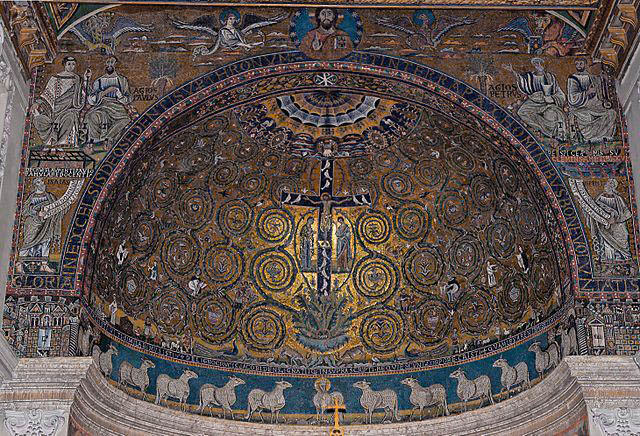
The most striking sight is the 12th-century apse mosaic, in a golden-bronze color and featuring a large crucifix in the center. Growing from and around the crucifix are vines, associating the cross with the Tree of Life.
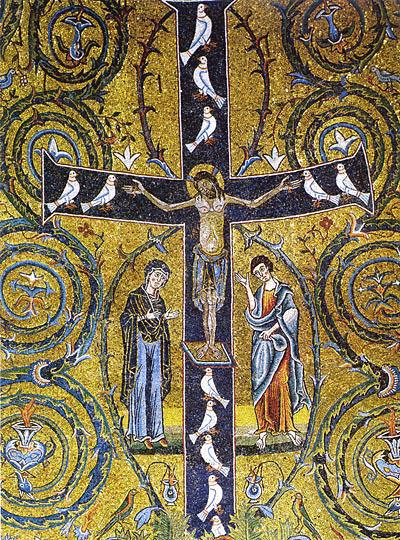
Crucifixion in the apse (12th cent)
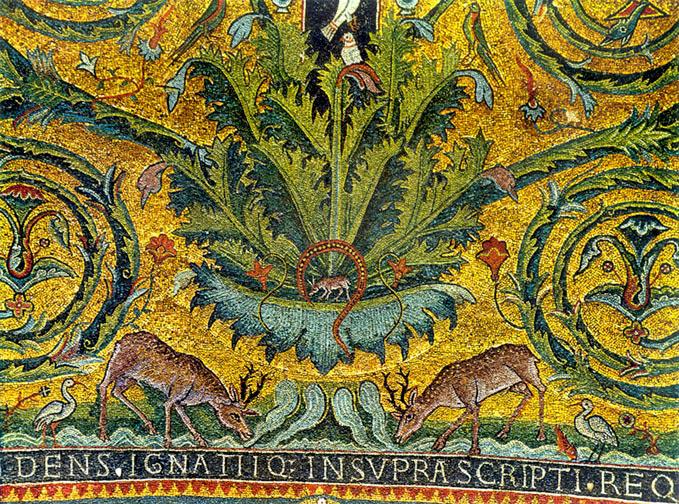
The Lower Church, 4th-9th cent
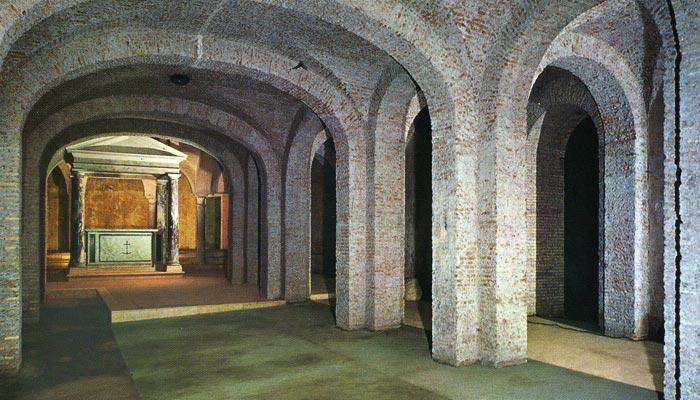
The interior of the 4th-century church is very
well preserved, but its frescoes (6th, 8th and 9th century) are quite
faded. Not all that you see here is ancient: significant changes were
made when this church was abandoned for the new one above.
After
the damage under the Normans, the colonnades between nave and aisles
were walled up. A third wall running down the nave as well as the
apse wall immediately behind the altar were also added to support the
upper church. Rows of supports
were added in the 19th century to add further support after
excavations removed 130,000 cartloads of rubble from here.
Originally, the 4th-century
church interior
consisted of a nave and two timber-roofed aisles with an apse at the
west end and a narthex at the entrance, fronted by an atrium
surrounded by arcaded porticoes.
Faded frescoes
decorate many of the walls, and date from the 6th to 11th centuries.
They depict New Testament scenes and lives of several saints.
At the end of the left aisle of the lower church, a 4th-century staircase leads down to the 1st-century insula (Roman apartment complex), much of which still remains unexcavated. The 3rd-century Temple of Mithras, down a narrow corridor to the left, was deliberately destroyed when the church was built, but one room has survived. It is a small artificial cave with stars on the ceiling, long side benches, and a stone altar with a relief of Mithras slaying the bull.
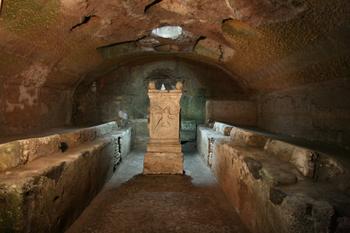
The 3rd-century Temple of Mithras
Piazza San Clemente, Via Labicana 95, Roma 00184, 2 blocks east of
the Colisseum
Bus: 85, 87, or 850
Mon-Sat: 9am-12:30pm and
3-6pm
Sun: 10am-12:30pm and 3-6pm
Excavations and lower church:
€3
Chiesa
Santi Quattro Coronati
Newly discovered 13th cent frescoes. 4th
cent-1246-1630
Close
to San Clemente
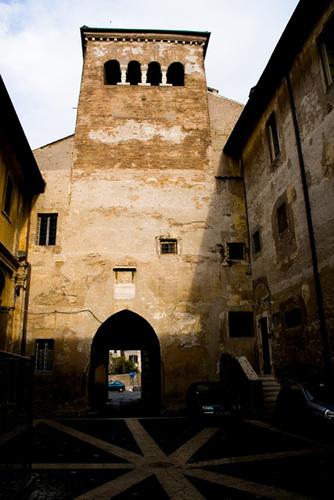
The sturdy castle of the convent of Santi Quatro Coronati, devoted to four anonymous saints and martyrs.
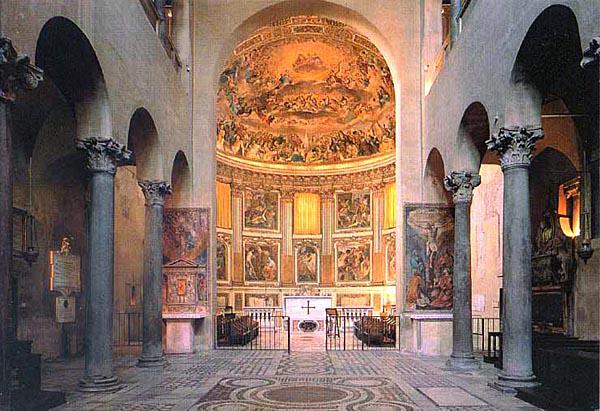
The church has retained its 4th or 5th cent shape. The apse was painted in 1630
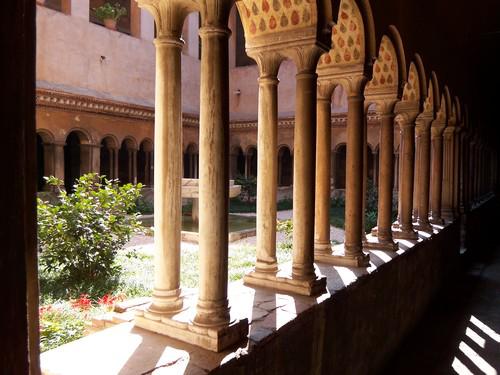
In the 13th cent. a lovely comatesc cloisters were added to the convent of the Augustine nuns
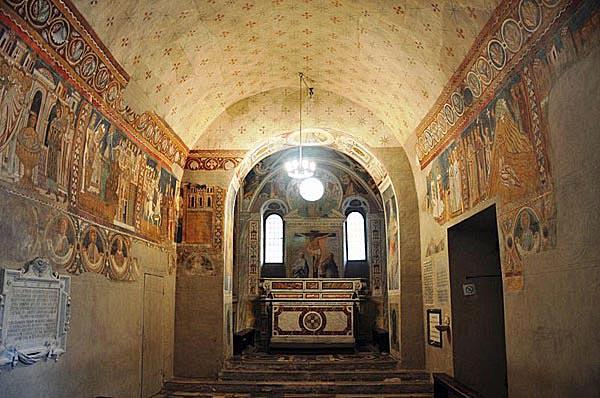
In 2002 a series of well preserved frescoes were discovered in the convents St. Silvestro chapel. They illustrate the "Donation of Constantine," a later recognized fake document attributed to Constantine who endows Pope Sylvester with all worldly power. Part this story is a confession of Constantine which is the subject of the fresco cycle
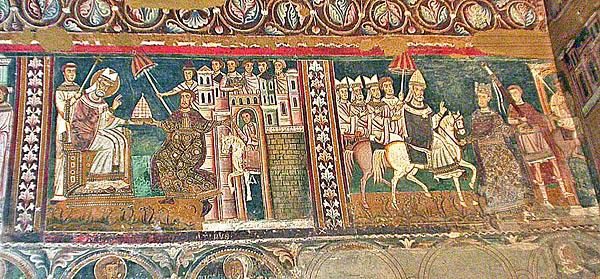
Pope Silvestro presenting Emperor Constantin with a papal tiara as a sign of the pope's authority over the empire.
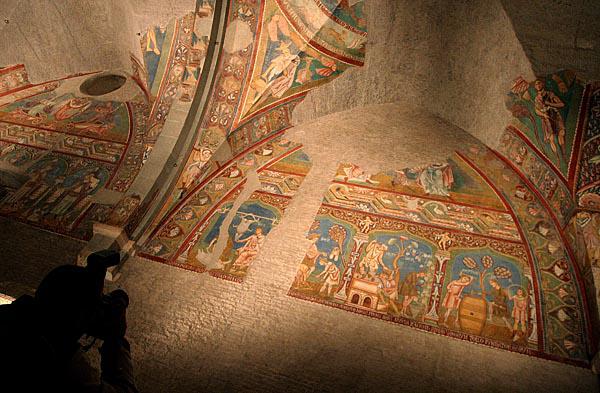
During restauration work in the past 5 years more frescoes came to light in a gothic oratorio of the convent.
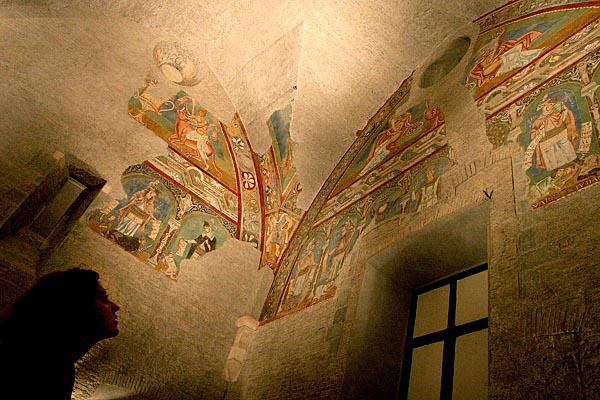
Surprisingly the 1246 fresco cycle depicts the seasons and other secular subjects of great art historical interest.
Santo
Stephano Rotondo
Monte Celio, Interesting architecture,
around
470
Santo Stefano Rotondo is one of the largest and oldest round churches in existence. Dating from the 5th century, it is a fascinating church that reflects both local and foreign influences. The church stands on the very crest of the Celian hill, in an area that was mostly uninhabited from ancient times until recently. Traces of the three chapels torn down with the outer ring in 1450 can be seen in the current outer wall by walking through the surrounding garden. Looking up at the clerestory you can see some Carolingian brickwork and scaffold holes from Pope Hadrian I's repairs.
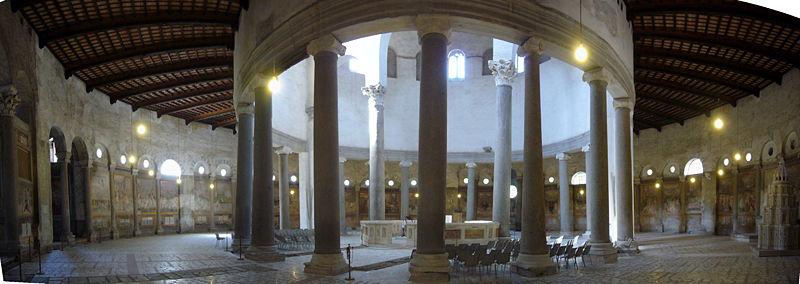
Probably built 470 AD after the devastation by the Vandales. Notice
the wooden ceiling.
Restored: 7th, 8th, 12th century and 1450
(murals)
Santo Stephano has the dubious merit of housing Rome's lagest collection of murals depicting executions of martyrs (1580s). "A hysterically extreme statement of the counter reformation. A kind of Sistine Chapel for sentimental sadists." (Robert Hughes)
Santa
Maria in Domnica
Via della Navicella 10, 9th
cent,
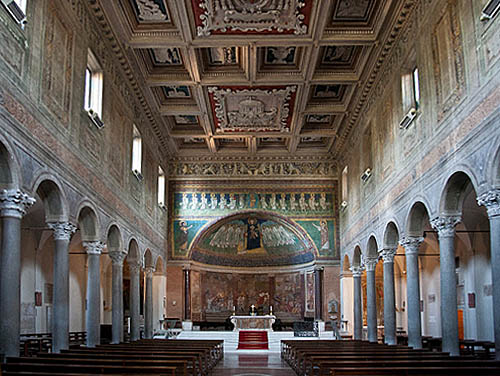
The church was built in the 9th cent. Pope Leo X renovated it in 1513-14,.Andrea Sansovino directing the works including the facade portico with tuscan columns. The internal columns are recycled from an ancient temple and crowned with Corinthian capitals. The ceiling is frescoed by Perin del Vaga, based on designs of Giulio Romano. The apse mosaic from the 9th century depicts Christ, angels, and apostles, Moses and Elias, Virgin and child on throne, and Pasquale I in ginocchio. There are also frescoes by Lazzaro Baldi (1624-1703)
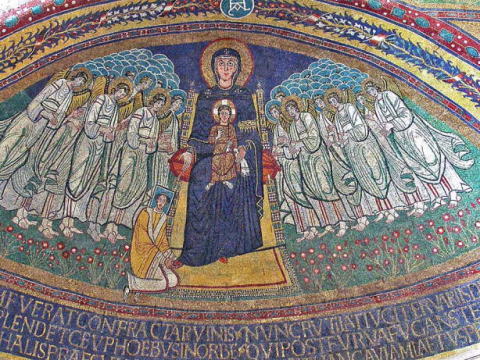
This part of the apse mosaic with a kneeling Pope Paschal I
(817-24)
appears to me to date to the 13th century
Basilica
di Santi Nero e Achilleo
Via Terme de Caracalla, east of Circus
Maximus, 4th
cent- 1579
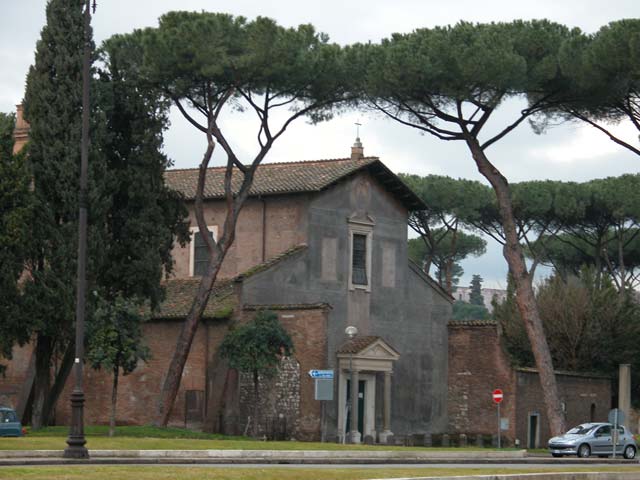
The unassuming 4th cent exterior is complimented by blood-curdling frescoes of martyriums (16th cent) inside
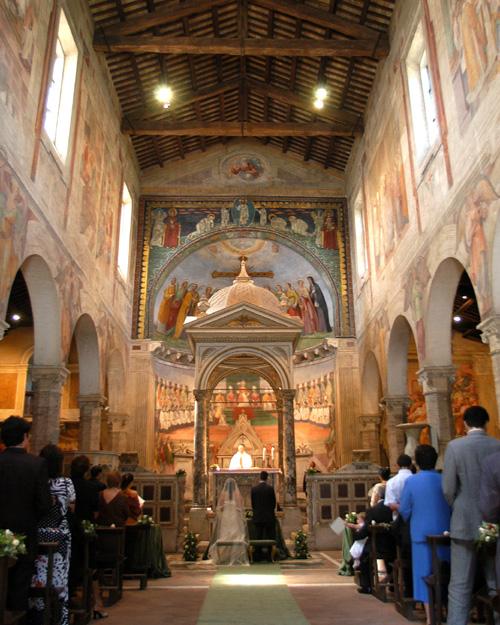
Have your wedding at this 4th cent church dedicated to two Christian-turned murderers. The present church is the result of a restoration by Cesare Cardinal Baronio - historian and titular priest of the church - in 1596-1598. The work was done carefully in order to preserve as much as possible of the ancient church and to restore ancient elements that had been lost. Some of the decorations that were added were taken from San Paolo fuori le mura.